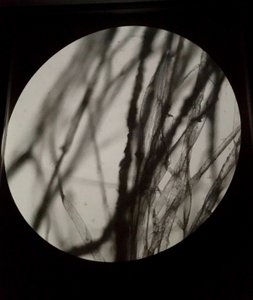Spheres and Cones. Plants as Practitioners
Spheres and Cones: Plants as Practitioners is a temporary discursive lab by Unstable Bodies directed by Wolfgang Tschapeller (Institute for Art and Architecture, Academy of Fine Arts Vienna). With Christian Freude, Christina Jauernik, Johann Lurf, Fabian Puttinger and guests.
Plants inhabit the rooms together with microscopic instruments, cooling systems, pumping circuits and projectors: a series of processual experimental setups, dislocations of view[1] and leaps in time. With nutrients, water, light and plants immersed in conversations, grown into each other.
The artistic-scientific research project Unstable Bodies explores plant modes of perception – what does "seeing" or "hearing" mean – and how they operate as collective, sensory forms of organization. It looks at interspecies collaboration and counteraction, experimenting with methods of translation and spaces of experience in the engagement with vegetal worlds.
What is at stake in this involutionary approach is a theory of ecological relationality that takes seriously organisms as inventive practitioners who experiment as they craft interspecies lives and worlds. … a “response-ability” in which questions of species difference are always conjugated with attentions to affect, entanglement, and rupture; it is an affective ecology in which creativity and curiosity characterize the experimental forms of life of all kinds of practitioners, not only the human ones. (Natasha Myers, 2012)
[1] Vitruvius draws an analogy between the proportions of temples and the human body. And thereby defines man as the measure of things in Book III of his treatise De Architectura Libri Decem (22 B.C.): „For the human body is so designed by nature that the face, from the chin to the top of the forehead and the lowest roots of the hair, is a tenth part of the whole height; …“. Charles Darwin, in turn, uses the body in a peculiarly similar way to capture the morphology of the plant: „The position of the antennae in this Catasetum may be compared with that of a man with his left arm raised and bent so that his hand stands in front of his chest, and with his right arm crossing his body lower down so that the fingers project just beyond his left side. In Catasetum callosum both arms are held lower down, and are extended symmetrically. In C. saccatum the left arm is bowed and held in front, as in C. tridentatum, but rather lower down; whilst the right arm hangs downwards paralysed, with the hand turned a little outwards. In every case notice will be given in an admirable manner, when an insect visits the labellum, and the time has arrived for the ejection of the pollinium, so that it may be transported to the female plant.“ (Charles Darwin, 1862)
Unstable Bodies, artistic research project (PEEK) AR574, funded by FWF Austria Science Fund.![]()
Spheres and Cones Drop-in:
The lab is open to the public from Wednesday to Friday between 11 am and 1 pm.
List of entries
-
–
Walk and Talk
with Ingeborg Lang und Isabel Kranz
Tour through the discursive lab of Spheres and Cones: Plants as Practitioners
Tour
–
Eschenbachgasse
Exhibit Eschenbachgasse

-
–
Plant Media Reading Group
Plant Media Reading Group is a bi-weekly gathering of thinkers and practitioners from diverse disciplines (architecture, philosophy, cinema studies, literary studies, anthropology, media theory), initiated by Vicki Kirby, Tom Lamarre, Christina Jauernik and Fabian Puttinger.
Reading Group
–
Eschenbachgasse
Exhibit Eschenbachgasse

-
–
Taking up Space with Sound
Soundshop with Christina Gruber and Natalia Domínguez Rangel
Sound workshop
–
Eschenbachgasse
Exhibit Eschenbachgasse

-
INTRA! INTRA! Towards an INTRA SPACE
Presentation of the volume INTRA! INTRA! Towards an INTRA SPACE of the publication series of the Academy of Fine Arts Vienna edited by Christina Jauernik and Wolfgang Tschapeller. With welcome words by Johan F. Hartle.
Book presentation
Eschenbachgasse
Exhibit Eschenbachgasse

-
–
Performative Setzung zur Erbse
with Esther Balfe, Diane Shooman and students of the Dance Program MUK Vienna
Movement Writing Research
Performance
–
Eschenbachgasse
Exhibit Eschenbachgasse



